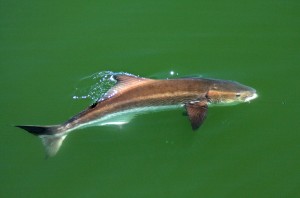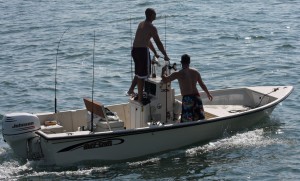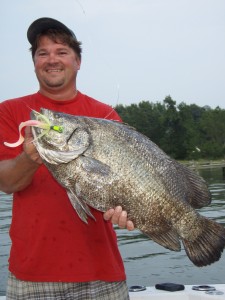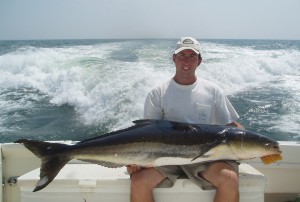Summertime Cruising
Published in Chesapeake Angler
Ken Neill
 Ah, the lazy days of summer. Our typical summertime fishing trip starts around 2 AM. We make the long run out to the 100 fathom curve and are trolling for tuna, wahoo and billfish before first light. We fish into the evening, get back in well after dark, and then we have all those fish to clean. All of that is if we are not doing an overnighter; then our trip is another day longer. Sometimes, it is good to be lazy and the long days of summer are the perfect time to do it.
Ah, the lazy days of summer. Our typical summertime fishing trip starts around 2 AM. We make the long run out to the 100 fathom curve and are trolling for tuna, wahoo and billfish before first light. We fish into the evening, get back in well after dark, and then we have all those fish to clean. All of that is if we are not doing an overnighter; then our trip is another day longer. Sometimes, it is good to be lazy and the long days of summer are the perfect time to do it.
 We have excellent sight-fishing opportunities in this area. You can fish from any size boat. Long runs to the fishing grounds are not required. You need next to no tackle. There is no need to get up “dark and early” and you can be home for dinner. The best thing is that you will catch big fish.
We have excellent sight-fishing opportunities in this area. You can fish from any size boat. Long runs to the fishing grounds are not required. You need next to no tackle. There is no need to get up “dark and early” and you can be home for dinner. The best thing is that you will catch big fish.
 The prime months for “cruising” are July, August, and September. The prime areas to look for fish are in the lower Chesapeake Bay from about York Spit to the Chesapeake Bay Bridge Tunnel and on out into the coastal waters. The main channels coming into the bay act as fish highways so cruising along the channel edges is productive. Each buoy marking these channels can be a fish holding structure as can be the numerous pilings of the CBBT. The waters over and around the shoals near the mouth of the bay are also good areas to find cruising fish.
The prime months for “cruising” are July, August, and September. The prime areas to look for fish are in the lower Chesapeake Bay from about York Spit to the Chesapeake Bay Bridge Tunnel and on out into the coastal waters. The main channels coming into the bay act as fish highways so cruising along the channel edges is productive. Each buoy marking these channels can be a fish holding structure as can be the numerous pilings of the CBBT. The waters over and around the shoals near the mouth of the bay are also good areas to find cruising fish.
The Fish
 There are several species that you will typically catch just by riding around looking for them. They are all large and put up a good fight. The fish that has most out there looking around is the cobia. For many, sight fishing for cobia is just more fun and productive than sitting on a chum slick. During the late summertime, cobia can be found cruising in open waters as singles, in pairs, or in larger pods of fish. They also like to stage next to the channel buoys and pilings of the CBBT this time of year, making them easy to find.
There are several species that you will typically catch just by riding around looking for them. They are all large and put up a good fight. The fish that has most out there looking around is the cobia. For many, sight fishing for cobia is just more fun and productive than sitting on a chum slick. During the late summertime, cobia can be found cruising in open waters as singles, in pairs, or in larger pods of fish. They also like to stage next to the channel buoys and pilings of the CBBT this time of year, making them easy to find.
 While cobia may be the most targeted fish for sight fishermen, the red drum actually may be the most exciting. Schools of big red drum can be encountered throughout the lower bay. Your best chance of finding them is at the mouth of the bay and along the coast from Smith Island on down to Sandbridge. The general Nautilus Shoal area is a good bet during the month of August. You may see them actively feeding on the surface with working birds over them. Often, it will just be a large area of color change in the water that you see in the distance. It will be much too large to be a school of fish but that is exactly what it is. When you find a school like this, you can stay with them for hours of constant action.
While cobia may be the most targeted fish for sight fishermen, the red drum actually may be the most exciting. Schools of big red drum can be encountered throughout the lower bay. Your best chance of finding them is at the mouth of the bay and along the coast from Smith Island on down to Sandbridge. The general Nautilus Shoal area is a good bet during the month of August. You may see them actively feeding on the surface with working birds over them. Often, it will just be a large area of color change in the water that you see in the distance. It will be much too large to be a school of fish but that is exactly what it is. When you find a school like this, you can stay with them for hours of constant action.
 Schools of large black drum can also be encountered in open water. They tend be less aggressive than their red drum cousins and will often sound as you approach them. To target black drum, your best bet will be to look around the four rock islands of the CBBT.
Schools of large black drum can also be encountered in open water. They tend be less aggressive than their red drum cousins and will often sound as you approach them. To target black drum, your best bet will be to look around the four rock islands of the CBBT.
 The next large fish that we commonly encounter while cruising around, is the jack crevalle. They arrive in the lower bay in late summer. You will see schools of them in open water and they will stage around the structure of the CBBT. The jack crevalle will be the hardest fighting fish that you will likely ever encounter in the Chesapeake Bay.
The next large fish that we commonly encounter while cruising around, is the jack crevalle. They arrive in the lower bay in late summer. You will see schools of them in open water and they will stage around the structure of the CBBT. The jack crevalle will be the hardest fighting fish that you will likely ever encounter in the Chesapeake Bay.
 There are other fish that will offer some sight-fishing opportunities while cruising around in the summertime. When you find schools of bunker bunched up on the surface, there are predator fish nearby. Bluefish, Spanish mackerel, a variety of sharks and even a tarpon can be encountered. There will be some odd catches of things like smooth puffer and do not be surprised if you see a big triple tail hanging next to a buoy. That is a fish we are seeing more of in the bay. A lazy afternoon of summertime cruising can lead to some very productive fishing.
There are other fish that will offer some sight-fishing opportunities while cruising around in the summertime. When you find schools of bunker bunched up on the surface, there are predator fish nearby. Bluefish, Spanish mackerel, a variety of sharks and even a tarpon can be encountered. There will be some odd catches of things like smooth puffer and do not be surprised if you see a big triple tail hanging next to a buoy. That is a fish we are seeing more of in the bay. A lazy afternoon of summertime cruising can lead to some very productive fishing.
 This fishing is done from every type of boat imaginable. Some height is an advantage and you will see many custom towers out there. It is not a requirement though, so whatever boat you have will get the job done. You will need a pair of polarized sunglasses. You can get by with just a single rod. A medium weight spinning outfit with 50-pound test braided line armed with a bucktail jig will catch just about anything that you will encounter. For cobia, having a second spinning outfit with a live eel ready to cast is a good idea. That is all that you need. Sleep in late, eat a nice brunch, cruise on out and catch yourself a big fish.
This fishing is done from every type of boat imaginable. Some height is an advantage and you will see many custom towers out there. It is not a requirement though, so whatever boat you have will get the job done. You will need a pair of polarized sunglasses. You can get by with just a single rod. A medium weight spinning outfit with 50-pound test braided line armed with a bucktail jig will catch just about anything that you will encounter. For cobia, having a second spinning outfit with a live eel ready to cast is a good idea. That is all that you need. Sleep in late, eat a nice brunch, cruise on out and catch yourself a big fish.
